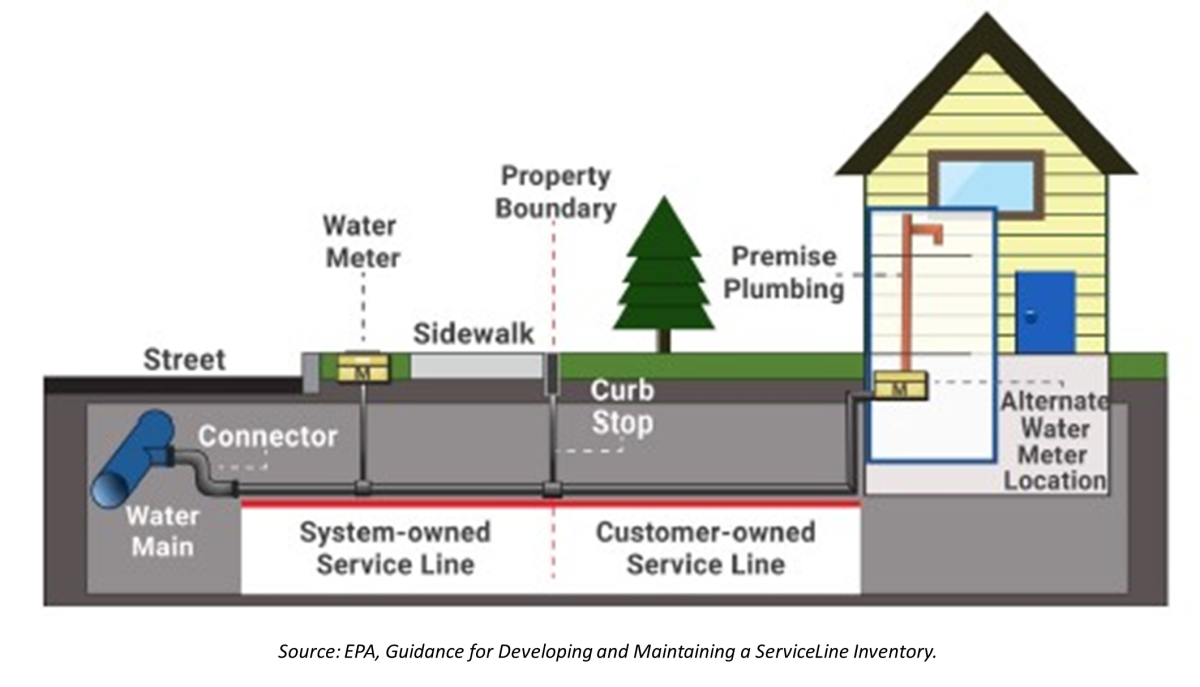
Telford Borough Authority's water mains are not made of lead, but the water lines inside your home may be.
Telford Borough Authority is asking for your help to identify the material of the service line entering your property. Having accurate information about the service line material will allow TBA to develop an inventory of all service line material, as required by the U.S. Environmental Protection Agency (EPA) and Pennsylvania Department oof Environmental Protection (PA DEP), and to better plan for and implement replacement projects more efficiently across the community, if needed.
This information will help TBA limit property disturbances in our efforts to verify service line materials in order to comply with federal and state regulations. However, there may be circumstances where TBA will need to pursue further investigations (i.e., in-house appointments, excavating a portion of a service line) depending on the availability of information and records related to service line material. TBA thanks all customers for their understanding and support as TBA works to comply with all federal and state regulations.
Please scroll down to the bottom of the page for instructions on how to test your pipes and how to submit the necessary information.
For any questions about lead in your water, call us at (215)-723-5000.
What is the Water System Doing About Lead in Drinking Water?
Telford Borough Authority (TBA) has engaged with the Horsley Witten Group (HW), Inc. and Eastern Research Group (ERG) to provide technical assistance to the TBA through the U.S. Environmental Protection Agency (EPA)’s Lead Service Line Replacement (LSLR) Accelerators Program. As part of this program, TBA is receiving free technical assistance to identify and develop strategies to replace lead service lines. TBA has already determined that the municipalities within TBA’s service area adopted ordinances and plumbing codes in the 1980s that prohibited the use of lead plumbing materials prior to the Pennsylvania Lead Ban, which became effective on January 6, 1991. TBA is now focused on identifying which homes and structures may have lead plumbing materials based on their construction dates to inform future outreach and investigations. To read more about TBA's future efforts, visit the LCRR Guide.
TBA has launched a community-wide project to identify the material of each customer's service line. This project is important to help avoid public health issues associated with exposure to lead in drinking water by guiding future lead service line replacement efforts. It is also required by U.S. Environmental Protection Agency (EPA) and Pennsylvania Department of Environmental Protection (PA DEP) regulations for TBA to inventory the material of each customer's service line, regardless of whether it is lead or a different material. TBA must also identify whether there are any lead connectors (the short section of piping that connects the service line to the water main, also known as a gooseneck or pigtail) present that should also be replaced.
TBA is also required to identify schools and certified childcare facilities within its service area and conduct lead monitoring (i.e., by sampling drinking water) at these facilities. This continues to be a priority for TBA and will continue to contact schools and certified childcare facilities for lead monitoring in accordance with federal sampling frequency requirements.
The federal government required that public water systems use "led-free" material through its 1986 amendments to the federal the Safe Drinking Water Act Amendments. These requirements were implemented at the state level in Pennsylvania through The Plumbing System Lead Ban and Notification Act, effective January 6, 1991 (often referred to as the "state lad ban"). If you live in a home built after January 6, 1991, it is unlikely that you have lead material in your service line or home plumbing. It is still important that TBA documents the material of your service line to comply with federal and state guidelines.
Because some homes within TBA's service area were built before January 6, 1991, these homes have a higher risk of having a lead service line or lead in other plumbing components. While TBA believes the use of lead service lines in the water distribution system was very rare, it is important to identify and replace any lead service lines to protect public health. Service lines that are galvanized steel and are currently or were previously downstream of lead materials (e.g., in the water main, service line, or connector pipes) can also be a source of lead in drinking water due to upstream corrosion. These galvanized steel lines (called "galvanized requiring replacement") should also be replaced. Service lines that are copper but were installed before the lad ban may contain lead solder. You should consider testing your water for lead if you have an older copper service line to determine if lead exposure is a concern and whether replacement is necessary.
Source of Lead in Drinking Water
The Telford Borough Authority's (TBA) drinking water sources are six groundwater wells drawing from the Brunswick Formation aquifer and water delivered through connections with the North Penn Water Authority system. The North Penn Water Authority system sources its drinking water primarily from the North Branch of the Neshaminy Creek, though it also has groundwater wells. TBA's water is lead free when it enters the distribution system, but lead can enter drinking water when water distribution and plumbing materials that contain lead corrode. Corrosion is the dissolving or wearing a way of metal cause by a chemical reaction between water and plumbing materials. Telford's water mains are not made of lead. The lead in drinking water is primarily from service lines (the pipe that connects the water main in the street to your property) and home plumbing.
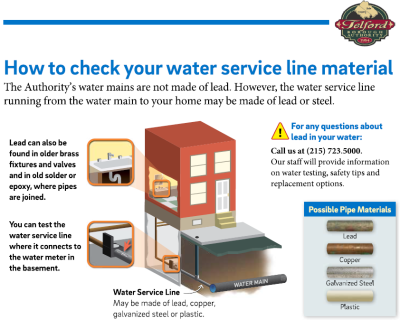
Service line Ownership and Responsibilities
A water service line is typically a small section of pipe that connects a water main in the street to a home or other property. TBA owns the drinking water mains in the street as well as the service line between the water main and the curb stop. The service line connects to the water main vis a short section of pipe called the connector (also commonly known as a gooseneck or pigtail). The curb stop is typically located at or near the property line and provides access to a value used to turn water service on and off to the property. The property owner owns and is responsible for the service line from the curb stop into the building. The system-owned and customer-owned service lines are separate pieces of pipe and may be made of different materials.
Drinking Water Supply Quality
The Telford Borough Authority (TBA) is committed to ensuring each of our customers has safe, high-quality drinking water that is also compliant with all government standards. TBA routinely monitors for contaminants in your drinking water according to Federal and State laws.
According to the 2022 Annual Drinking Water Quality Report, 0 out of 21 Telford Borough Authority drinking water sites contained enough parts per billion of lead to be above the EPA action level, which is a measure of how effective treatment controls are. In the 2022 report, 0 out of 31 of the tested customer taps over a span of 4 months contained enough lead to be above the EPA action level. Where lead in drinking water was detected at their sampling sites, it was determined that the source of lead was from the corrosion of internal household plumbing systems and not from Telford's water pipes. DURING 2022, TBA DID NOT VIOLATE ANY DRINKING WATER STANDARDS. Although TBA complies with all state and federal drinking water quality standards, identifying and removing service lines that may be a source of lead is an important way to protect public health.
The report provided in 2022 includes details about our water sources and volume, what the water at your tap contains, and how it compares to standards set by our regulating agencies. We are pleased to report that TBA was in complete compliance with all water quality criteria in 2022. We want our customers to be informed about their water quality. To learn more about this report click on the file below.
Public Health Effects of Lead in Drinking Water
Exposure to lead in drinking water can cause serious health effects in all age groups. Infants and children can have decreases in IQ and attention span. Lead exposure can lead to new learning and behavior problems or exacerbate existing learning and behavior problems. The children of women who are exposed to lead before or during pregnancy can have increased risk of these adverse health effects. Adults can have increased risks of heart disease, high blood pressure, kidney or nervous system problems.
Lead in drinking water is primarily from materials and components associated with service lines and home plumbing.
TBA is responsible for providing high-quality drinking water but cannot control the variety of materials used in plumbing components. When your water has been sitting for several hours, you can minimize the potential for lead exposure by flushing your tap for 30 seconds to two minutes before using water for drinking or cooking. If you are concerned about lead in your water, you may wish to have your water tested. Information on lead in drinking water, testing methods, and steps you can take to minimize exposure is available from the EPA Lead website.
To read more about lead in drinking water visit the Department of Environmental Protection website.
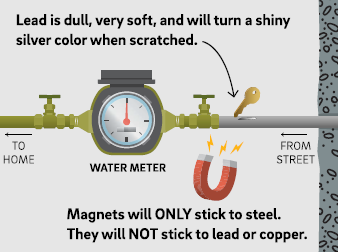
What if I Have Lead Pipes?
Websites commonly have information on how customers can reduce their exposure to lead. Systems also tend to include information about how customers can request water quality testing and water filtration devices. Systems may want to review their internal capacity to manage requests for water quality testing and water filtration devices (as well as the current regulatory requirements) before including such language on their websites; however, systems should also be prepared for the possibility that customers will contact them with questions about testing or filtration devices. It is important to note that providing water quality testing and filtration devices are regulatorily required in certain cases (see the Lead and Copper Rule Revisions Communication Requirements section above), but some systems offer these services to customers more generally, going beyond regulatory requirements. Sample public education language focused on reducing exposure to lead in drinking water is included below in italics.
If you have a lead service line or believe you may have interior plumbing that is lead, you can take the following steps to reduce your exposure to lead in drinking water:
- Use cold water for drinking or cooking. Never cook or mix infant formula using hot water from the tap. Boiling water will not remove lead.
- Make it a practice to flush your pipes to remove lead before consuming drinking water, especially after long periods of no use (i.e., a few hours or overnight). You can flush your pipes by running your tap for several minutes, taking a shower, doing laundry, or doing a load of dishes.
- It is safe to shower and bathe even if you have a lead service line as long as you do not consume the water. Human skin does not absorb lead in water.
- Routinely clean faucet screens (also known as aerators, these are the small faucet tip attachments that regulate water flow). Sediment and metals can collect in the faucet screen located at the tip of your faucets. Replace screens that are in poor condition.
- Consider using a point of use (POU) drinking water filter to remove impurities from drinking water. Check for a POU filter that has been tested against the NSF/ANSI Standard 53 and has a claim of lead reduction and make sure to follow its instructions for replacing filters regularly. See EPA’s guide for identifying POU filters.
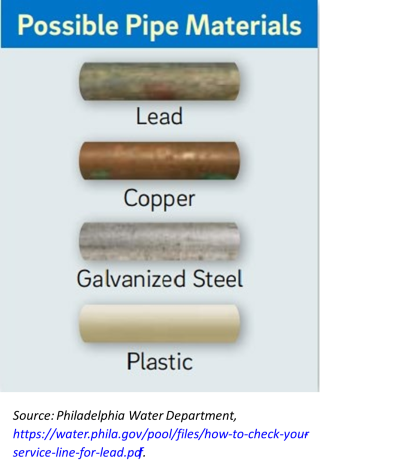
Customer Self-Identification of Service Line Material
Your service line may be lead, copper, galvanized steel, or plastic.
Lead pipes are silvery gray and easily scratched. They typically have a round or bulbous shaped section where the line connects to the interior plumbing, called a wiped joint. If you have a lead service line, it should be replaced.
Galvanized steel pipes are also a gray metal color. They will make a metallic ringing sound when tapped and magnets will attract to galvanized pipe. If you have a galvanized steel pipe, it may need to be replaced if it is or was downstream of lead material because it can be a source of lead exposure due to upstream corrosion.
Copper pipes vary in color depending on their age, just like a copper penny. A new copper pipe will be shiny and orangish but will turn dark brown as it ages. If you have a copper service line, it won’t be a source of lead, but lead could still have been used in the solder at the pipe joints if your pipe was installed prior to the effective date of the Pennsylvania lead bans (January 6, 1991). You should consider testing your water for lead if you have an older copper service line to determine if lead exposure is a concern and whether a replacement is necessary.
Plastic or PVC pipes come in many materials and colors. When tapped, they will not have a ringing sound like a metal pipe. If your service line is plastic, that indicates it is a recent plumbing installation and won’t have lead solder.
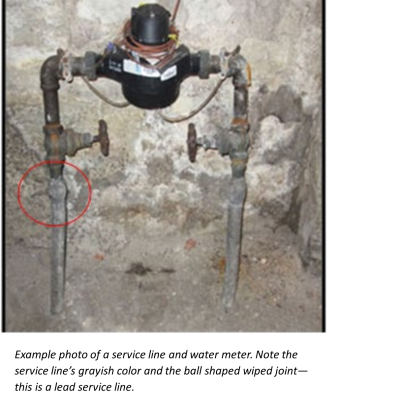
Follow the steps below to check your water service line material and report this information to TBA.
You will need:
- Key, coin, or flat-head metal screwdriver
- Strong magnet
- Camera
Step 1: Conduct a Scratch & Magnet Test
You can test the water service line where it connects to the water meter in your basement. Your water service line will either be lead, copper, galvanized steel, or plastic. If you do not have a water meter in your basement, skip to Step 3.
- Find the water meter in your basement. The water service line is the pipe that comes through the outside wall of your property and connects to the meter.
- Carefully scratch the surface of the pipe with a key, coin, or metal flat-head screwdriver. Do not use a sharp tool and be careful not to make a hole in the pipe. If the pipe is painted, gently use sandpaper to expose the metal before scratching it.
- Place the magnet on the pipe. Check if the magnet sticks to the pipe.
- Next, check your results:
- If the scratched area of the pipe is shiny and silver in color AND a magnet does NOT stick to the pipe, your service line may be lead.
- If the scratched area of the pipe is orange or red in color like a copper penny AND a magnet does NOT stick to the pipe, your service line is likely copper.
- If the scratched area of the pipe is dull and gray in color AND the magnet DOES stick to the pipe, your service line is likely galvanized steel.
- If you can’t scratch your pipe, it doesn’t produce a ringing sound when tapped, AND the magnet does NOT stick to the pipe, your service line is likely plastic or PVC.
Step 2: Take a Picture
TBA staff need at least one (1) photograph of your service line to help verify your results. Please take the following photograph:
- Take a photograph of your service line where it connects to your water meter from the side. Make sure to include the service line and meter in the photograph. See the example photo above.
Step 3: Report this Information to TBA
Please send your results and pictures to TBA by filling out the form below or emailing manager [at] telfordborough.org. TBA staff will review. If TBA staff is unable to verify the material of your service line based on the submitted information, they will contact you for more information or to schedule an in-house appointment.
